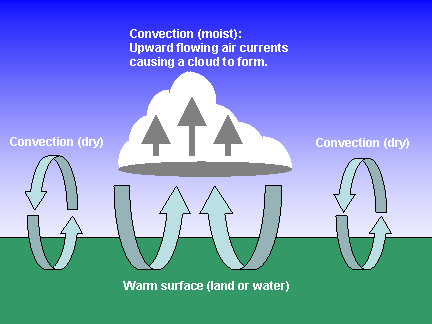Homework: You will have an open notes quiz tomorrow.
First read the paragraphs below about convection. Then read about atmospheric circulation here.

The one way that heat is transferred from one place to another is convection. Convection takes place when heated molecules move from one place to another, taking the heat with them. Convection is common in both the atmosphere, as well as in the oceans.
Heated air in our atmosphere expands, becoming less dense. Because it is less dense, it rises upward. Cooler air rushes in to replace the air that lifted up. As warm air rises, and cool are falls, a giant circular pattern is created. Eventually the warmer air cools, and begins to fall again. [1]
| "Convection" has several, related meanings in weather....but it always involves rising air. It usually refers to "moist convection", where the excess water vapor in rising air parcels condenses to form a cloud. The heat released through this condensation can help to sustain the convection by warming the air further and making it rise still higher, which causes more water vapor to condense, so the process feeds on itself. Convection can also be dry, as occurs on a sunny day over the desert. The sun warms the ground, and convective air currents help to remove the excess heat from the surface. Dry convection also occurs during the day even when clouds are forming...you just can't see it. |
| Interesting facts: |
| MAKING THE EARTH LIVEABLE: Convection (both dry and moist) help to make the Earth liveable by removing excess heat from the surface, and transporting it high into the atmosphere. It has been calculated that, without convection, the average surface air temperature on the earth would be about 125 deg. F, rather than the current 59 deg. F. [2] |
No comments:
Post a Comment